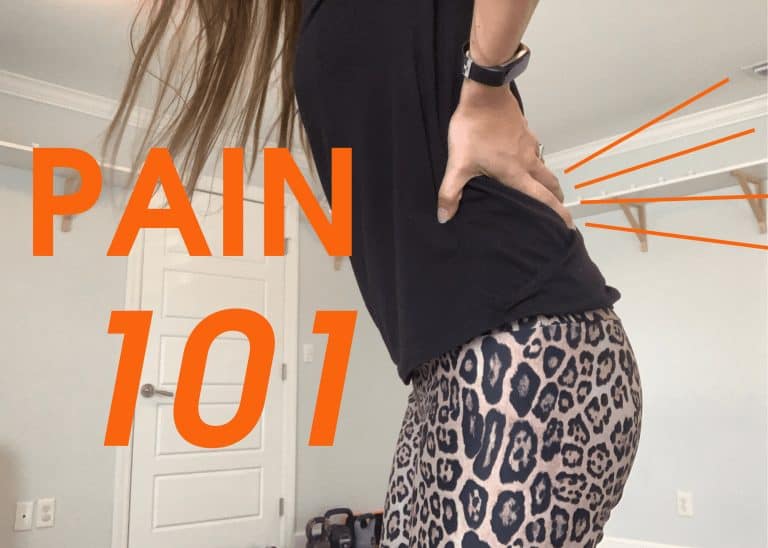I’m going to tell you something you don’t want to hear: I do not have a magic wand, and I cannot magically heal your pain with yoga. In fact, yoga for pain relief isn’t always the right answer.
However, what I can tell you is this: Whether you have low-back pain, bone spurs, joint pain in your knees or shoulders, chronic headaches, or any other frequent or ongoing issues with pain, you need to know the information I’m about to share in this article.
Your Brain Creates Pain
Most of us misunderstand the way pain works. We assume that our body feels pain. That’s not actually the case.
In fact, your body experiences “sensation.” It doesn’t pass any judgment about whether that sensation is good or bad, harmful or helpful. Through your nerves, the body communicates sensation to the brain.
Then, the brain makes a “decision” (obviously, not a conscious one), about whether or not this experience is pain. And it sends that signal back out to the body, creating a chemical reaction that causes the felt experience of pain. So, it is in fact your brain that feels pain.
When this system is working well, our brain and body team up (picture a three-legged race where the brain is one person, the body is the other person, and the nervous system is the rope that ties them together) to help us experience pain and adjust our activity to avoid damaging our body.
When our brain and body aren’t working well together, the three-legged race goes awry. There are people in the world who have genetic conditions that can cause them to experience constant pain without a physical cause, and others who never experience any pain, even when they’re hurt. You can probably imagine the negative effects that might have.
Most of us, however, are somewhere in the middle. Ideally, our brain only creates pain when there is a physical cause, though sometimes we may experience pain for longer or more severely than the tissue damage itself merits.
How Your Nervous System Affects Pain
I mentioned above that the nervous system is the tie between the brain and the body. It’s like the phone line through which they communicate.
Our nervous system can get “up-regulated” (stressed) or “down-regulated” (relaxed) based on our internal or external landscape.
In our deep ancestral history, our body was designed to ramp up when faced with a threat. If a lion attacked us, our nervous system would jump into fight or flight mode. In that state, we are more alert, our muscles tense, our breathing gets shallower in order to hyper-oxygenate the blood, and stress hormone is created. This puts us in a better position to either beat or outrun the lion.
Of course, when you escape this close call, you’ve got that lovely runner’s high created by endorphins, you get to collapse with relief, and your body relaxes. You shift toward a calmer state of rest and digest.
The human body is designed to ebb and flow between these states. In the Taoist tradition and Yin Yoga, this is represented by the Yin Yang. Two equal parts of a whole.
However, most of us spend our lives in fight or flight nearly all the time. Let’s say you receive an email that stresses you out. This doesn’t have the clear beginning and end, win and lose that a fight with a lion does. Our body doesn’t receive that clear signal to relax. Instead, we’re surrounded by more and more bright screens, pinging notifications, traffic, and all the other trappings of modern life and we stay in fight or flight.
Spending so much time in fight or flight takes a toll on our body, our brain, and our nervous system. For example, when under chronic stress, we’re more aware of pain or discomfort. And we lack the opportunity to heal injury, which is done during rest and digest.
Somatization: Yes, It’s All in Your Head (and in Your Body)
Here’s a fun vocab word for you: “Somatization is a tendency to experience and communicate psychological distress in the form of somatic symptoms and to seek medical help for them. More commonly expressed, it is the generation of physical symptoms of a psychiatric condition such as anxiety.”
In other words, what’s going on in your head can create pain in your body. When our brain and nervous system are constantly stressed by our outside environment as well as our internal thinking, it can create more pain. This may mean pain from an injury presents as more painful than the damage alone seems to justify, or that pain is created in the body with no physical trigger at all.
So often I hear clients tell me that their doctor basically told them their issue was “all in their head.” And until a few decades ago, doctors actually did believe that pain without an inciting event was completely made up.
Fortunately, we now recognize that even if pain is created in the head (not as the result of a physical sensation), it is still experienced in the body. And it can and should be treated both in the body and in the head.
Calm Your Nervous System to Relieve Pain
If you’ve ever taken a psychology class, you’re probably familiar with Maslow’s hierarchy. It basically expresses that our needs as humans must be met progressively in a specific order: without a foundation of physical safety and resources, we can’t move on to higher levels of self-fulfillment.
The same is true in our physical bodies. So many people come to yoga for pain relief imagining that if they do some strenuous poses (or heck, even gentle poses) for an hour a day, they’ll get relief. Unfortunately, that’s not how it works.
Our physical body first needs to be fed and nurtured with good food and plenty of sleep. Without these things, no amount of Warrior 1s will make you stronger, more supple, or more pain-free (or at least, not very quickly).
Then, we need to manage our mental and emotional state; reducing stress and more effectively handling our emotions. A ramped up (or heck, even overly ramped down) nervous system will not allow for healing and pain relief.
Then, we move on up the pyramid to things like yoga, stretching, physical therapy, and mobility exercises. This is where everyone wants to start without taking care of the foundation first!
Lastly, we add things like cardio exercise and weight lifting. Again, these are essential for your best health! However, weight lifting is designed to essentially damage your muscle tissue; if you’re not eating, sleeping, relaxing, and moving in ways that support that recovery, you will create more injury and pain.
How to Move for Less Pain
OK, so let’s say you’ve taken care of the diet, sleep, and emotional factors. You are blissfully at peace — yet you’ve still got that nagging knee pain. This is where we start to think about using physical exercise to reduce pain.
I like to describe all musculoskeletal injuries as having essentially one cause: Something in your body is doing a job it wasn’t designed for.
For example:
- The muscles around your mid-back are weak and don’t hold your shoulderblades where they should. So, your upper shoulder and neck muscles are suspending and moving them from above. All the time. These muscles weren’t designed to do that, and this will present as pain and tightness in the neck and shoulders.
- Or, you do 1,000 forward folds in yoga where you hang forward on your hamstrings for minutes or even tug to get deeper into the stretch. Your hamstrings are so loose, that the tendon that attaches the hamstring to the sitbone is now the only thing holding you in one piece. This tendon will inflame and hurt.
- Or, you unconsciously roll your knee in or out as you walk and run. You lack strength in the muscles that stabilize the knee in motion. So instead, you rely on the ligaments of the knee joint to stabilize, a job they weren’t designed for that creates pain or damage over time.
To wildly generalize, just about every one of these issues can be resolved with two steps: First, relax and release the thing that’s working but shouldn’t be. Then, strengthen the thing that should be doing the work instead.
It’s that simple! I could give you a whole bunch of examples of where this is true, but here are a few examples:
- You get a massage to relax your neck and shoulders and then start practicing pull-ups and serratus push-ups to strengthen the stabilizers that should be holding your shoulderblades.
- You apply ice and heat to your hamstring tendon, and then strengthen the hamstring. (Adjusting posture to stop tugging the tendon would probably help, too.)
- You support the knee joint with a soft brace while exercising to give it a sense of security, and then strengthen the lower quad and knee stabilizers.
Of course, this is a simplification, but this is truly all there is to it.
Pain: It Ain’t Always What You Think
If you have sore, “crunchy” shoulders and neck muscles, you probably imagine it’s from constantly tightening your shoulders. So, you start actively pulling your shoulders down your back. This doesn’t help; in fact, it makes things worse!
Sometimes, we assume that what feels like tightness is an over-worked, shortened muscle that needs to be stretched more. In fact, sometimes what feels like tightness is a muscle that is being over-stretched, and has responded by tightening and reducing movement. This muscle needs to be relaxed not stretched.
How do you know which you have? Well, if what you’re doing isn’t working, then maybe you’ve got the opposite problem!
I also want to mention that sometimes where you experience pain has nothing (or little) to do with where you need to fix it. For example, knee pain can come from imbalance in the hip or foot.
This is where it truly helps to have an expert pair of eyes on you. If you need support in thinking critically about where your issues are coming from or how to address them, schedule a wellness consultation.

